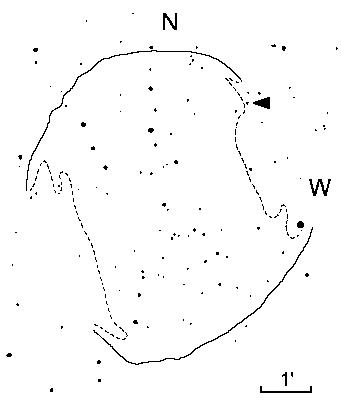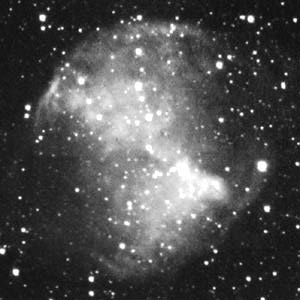Goldilocks' Variable
![[Discovery images]](../../Pics/Leos/glcompare.jpg) One of the most exciting times of my life followed after I realized that
a reddish star easily visible on the cover of the June 1990 issue
of
Astronomy was completely lacking on the cover of the Autumn
1990 issue of Deep Sky which, by a remarkable coincidence,
showed apparently the same Dumbbell nebula (M 27,
NGC 6853). Reproduced by permission. Copyright © 1990,
Kalmbach Publishing Company.
One of the most exciting times of my life followed after I realized that
a reddish star easily visible on the cover of the June 1990 issue
of
Astronomy was completely lacking on the cover of the Autumn
1990 issue of Deep Sky which, by a remarkable coincidence,
showed apparently the same Dumbbell nebula (M 27,
NGC 6853). Reproduced by permission. Copyright © 1990,
Kalmbach Publishing Company.
To put it lenghtily, all that began a long time ago, well before
the Internet entered my life. Getting
acquitanced with the fascinating world of planetary nebulae, I found,
much to my surprise, that many of them had their stellar nucleus
double. A popular book on astronomy (I can't
recall its title now)
even said that also the brightest planetary, the Dumbbell nebula
(M 27, NGC 6853) belonged to the class. Unfortunately,
as it is often with similar sources, no reference or authority was
given, and I forgot the episode.
A couple of years later I used to make regular
trips to the library
of the Astronomical Institute
in Ondrejov, a quiet village in a
nice hilly landscape some 30 kilometers from Prague, with forests all
around and great beer in local pubs. By that time I had
already learned to read technical papers and now I got access to the
large library full of goodies! Browsing through bibliography of
planetary nebulae in hefty volumes of Astronomy and Astrophysics
Abstracts, I came across a paper "A probable binary central
star in the planetary nebula NGC 6853" (PASP 89, 139,
1977) by Kyle M. Cudworth of the
Yerkes Observatory.
Comparing positions of a 17th magnitude star next
to the nebula's nucleus (separation 6.5", position angle 214°)
measured at Lick and Yerkes plates in the 1960s and 1970s, he found that both
the stars moved together and suggested they could be physically
related to each other.

|
|
Finding chart for Goldilocks' variable (arrowed). The
common-proper-motion
companion of the stellar nucleus is a small star next to (and southwest of)
the latter.
|
I knew that binarity of some other planetary nebulae was much more
dramatic (as it is with
V 651 Mon, the unique nucleus of NGC 2346), but this was
a little known detail I could add to a picture of a well-known object.
Having realized that the common-proper-motion companion was visible on
many published pictures of the summer planetary, I decided to
prepare a map which would show the
nebula's extent in various colors (and the light of various ions)
and also that pair of the stars. Hoping, of course, that I would find
other interesting features to be marked on the chart. I took June 1990
issue of Astronomy with a beautiful blue-red bubble of the
Dumbbell (captured with the Canada-France-Hawaii
Telescope) on its cover, and started plotting
the star field on a tracing paper. To check my creation I reach for
the Autumn 1990 cover of Deep Sky which, by a remarkable
coincidence,
showed apparently the same Dumbbell, with similar orientation and
scale. I corrected position of a few small stars when I got to the
northwestern corner of the nebula and became puzzled. The place
occupied on the cover of Astronomy by an easily visible reddish star
was quite empty on the Deep Sky picture! I had never heard
about a variable star in
M 27 so I began eagerly chasing after photographs of
the planetary.
When I emerged from books and journals heaped up during the search,
I was sure that the star was really a variable, not an artifact due
to some misprint, different magnitude limit or color sensitivity.
I was looking forward to add to my chart a detail completely
forgotten by authors of deep-sky guidebooks, but first I had to find its
coordinates to check them against variable star lists. First aid was
given by the image of M 27 reproduced in Perek &
Kohoutek's Catalogue of Galactic Planetary Nebulae, the only
source at my disposal with clear orientation, angular scale and
coordinates of the stellar nucleus. During my next visit at the
Department of Theoretical Physics and Astrophysics, Masaryk
University, Brno, I went through the General Catalogue of Variable
stars (GCVS) that listed variable stars known in early 1980's, as
well as its more recent supplements. But none of those authoritative sources
mentioned the star of the Astronomy cover! I determined the
position again allowing for a pessimistically large error, checked
the latest numbers of
IBVS
(Information Bulletin of Variable
Stars), but the result was the same. Finally, I admitted
the star was a discovery, and sent a short announcement
to IBVS through Attila Mizser
(Konkoly Observatory).
An enjoyable response - a small card saying that the
contribution was accepted and would appear in #3604 -
came within a few days.
|

|
|
It required 24 individual exposures of six fields to create this
CCD mosaic of the Dumbbell Nebula. Daniel Del Rio (Fort Lauderdale,
Florida) took them on November 23, 1994, with a ST-5 camera attached at
his 14.5-inch reflector.
|
That happened in the spring of 1991. What is known about the variable
today, six years later? The most precise piece of information is its position.
Soon after the discovery, Jan Manek (Stefanik Observatory, Prague) found that
my original coordinates were erroneous. Applying standard astrometric procedures to
a pair of photographs of the Dumbbell which appeared in print, he derived
new declination and right ascension:
19 h 59 m 29.8 s, +22° 45' 14''
(2000.0, precessed from the original 1950.0 equinox using the NED online
calculator). However strange his method may seem, it worked surprisingly well.
In the summer of 1992, Petr Pravec (Astronomical Institute, Ondrejov) took at my
request several CCD frames of the planetary nebula and measured them with the
following result: 19 h 59 m 29.7 s, +22° 45' 12'' (2000.0).
The third (and so far the last) position I am aware of is that published
by M. Morel (Rankin Park, Australia) in the IBVS #4037 (Improved
Astrometry for Variable Stars): 19 h 59 m 29.8 s,
+22° 45' 13'' (2000.0). As you can see, the three sets of coordinates
agree perfectly with each other, given that the first one is based on
the SAO catalog and the others on the GSC data.
Unfortunately, situation with the variable's photometry is much worse.
It seems most likely that it belongs to the class of long-term variables of which Mira
(Omicron Ceti) is the most popular representative. This is indicated by the
red color of the star, the reason it's so bright on frames taken by common
CCD cameras and on the near-infrared image of the Dumbbell nebula reproduced
in the September 1996 issue of the Sky & Telescope, page 16.
More importantly, the classification is supported by character of light changes
documented by a series of CCD frames made by Daniel Del Rio (Fort Lauderdale,
Florida) during the fall of 1994. Using the ST-5 camera attached at his 14.5-inch
Newtonian, he got so far the best brightness measurements. Alhough relative and unfiltered,
Daniel's photometry show that the variable has brightened by some two magnitudes
between the early October and the late November of that year (the check star nearby was constant
within a few hundredths of magnitude).
This is too much for other sorts of red variables (those various semiregular
and irregular beasts). In addition, the real range may be even greater, because
the images of the variable and comparison star turned out to be saturated.
But that all isn't enough for giving the star (which I privately
named Goldilocks' variable after a ravishing young lady) the
definitive designation V XXX Vul. With Vulpecula the Little Fox rising again above
the morning horizon (now decorated with the comet),
it should be quite easy for an experienced variable star observer equipped
with a CCD camera (and ideally also with the standard R or V filter) to follow
its changes closely thorough a cycle or two. Needless to say, I would
much appreciate any results. Clear skies!
(March 1997)

First update
While the comet mentioned above is finally gone, Goldilocks' variable is
still out there, and what is most important, you can enjoy a preliminary
light curve prepared by
Rudolf "Karel" Novak
(Nicholas Copernicus Observatory and Planetarium, Brno).
Between April and early July 1997, he took several frames
with a ST-7 CCD camera (R-band Kron-Cousins filter) attached at
the Brno Observatory 40 cm (f/4.4) reflector,
and processed them by the MIDAS aperture photometry function magnitude/circle.
The results are presented in the accompanying diagram. The top panel shows the magnitude
difference between the variable and a comparison star, the bottom panel the same for the
comparison and a check star.
Rudolf's most recent measurements (not included in the diagram yet) indicate that
Goldilocks' variable has already reached its minimum and is brightnening.
(September 1997)

To Attila Mizser (Konkoly Observatory) who arranged publication of
my discovery report in IBVS. To Petr Pravec (Astronomical
Institute, Ondrejov) and Jan Manek (Stefanik Observatory, Prague) for
their careful positional measurements. To Daniel Del Rio for an
envelope full of goodies related to the Dumbbell Nebula and nice CCD
images. To Dave Bruning and Terry Conley (Astronomy) for
permission to reproduce the discovery images. And to Rudolf Novak for
his present and future photometry of my favorite variable star.
Leos Ondra
(leo@sky.cz)
October 16, 1998
Hartmut Frommert
(spider@seds.org)
Christine Kronberg
(smil@lrz.uni-muenchen.de)
![[SEDS]](../../Jco/seds1.jpg)
![[MAA]](../../Jco/maa.jpg)
![[Home]](../../Jco/messier.jpg)
![[Back to M27]](../../Jcon/m27.ico.jpg)
Last Modification: 19 Feb 1999
![[Discovery images]](../../Pics/Leos/glcompare.jpg) One of the most exciting times of my life followed after I realized that
a reddish star easily visible on the cover of the June 1990 issue
of
Astronomy was completely lacking on the cover of the Autumn
1990 issue of Deep Sky which, by a remarkable coincidence,
showed apparently the same Dumbbell nebula
One of the most exciting times of my life followed after I realized that
a reddish star easily visible on the cover of the June 1990 issue
of
Astronomy was completely lacking on the cover of the Autumn
1990 issue of Deep Sky which, by a remarkable coincidence,
showed apparently the same Dumbbell nebula 


![[SEDS]](../../Jco/seds1.jpg)
![[MAA]](../../Jco/maa.jpg)
![[Home]](../../Jco/messier.jpg)
![[Back to M27]](../../Jcon/m27.ico.jpg)